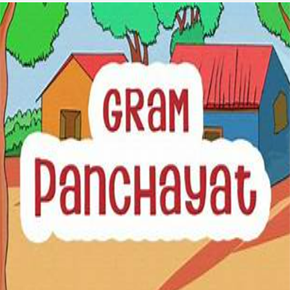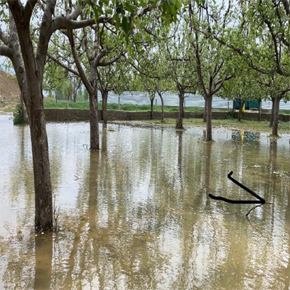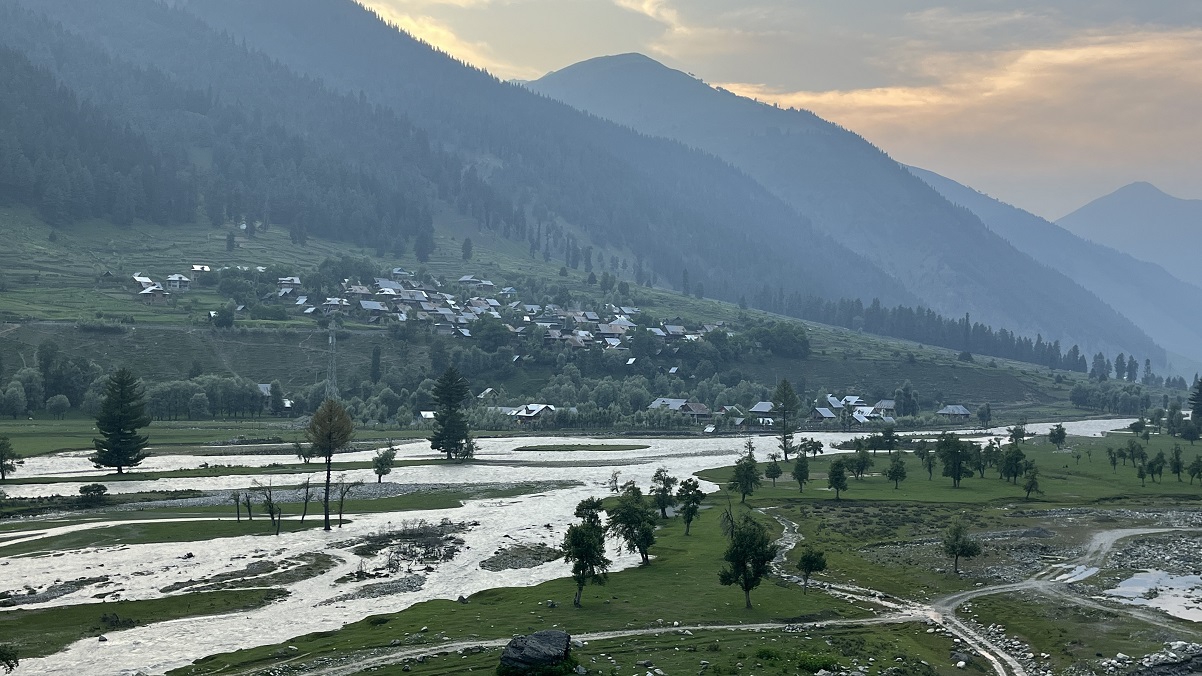Har Gaon Hariyali' Will Increase Our Carbon Stock - Jammu And Kashmir
The details of the plantation should be made public in every village to ensure transparency in this revolutionary programme.
THE Forests play an important role in keeping climate change under control. They sequester more carbon than any other natural ecosystem and thus forests are both sources and sinks of carbon. The destruction of forests leads to decrease in carbon stock as forests are the major stores of carbon.
According to a report published in Mongabay, a leading environmental web magazine, from 2015 to 2018 India has lost dense forests the size of Kolkata within four years.
Quoting Chief Conservator of Forests Agra, the report said that as per official data, over 20,000 hectares of forest area was diverted for thermal power plants,mining and several other infrastructure projects. Jammu & Kashmir has also lost a huge amount of forest cover in the last 30 to 40 years. Thousands of hectares of forest land with huge tree cover has been transferred for construction of hydropower projects,dams, transmission lines and highways. During this process, thousands of trees have been axed on the orders of the Forest Advisory Committee (FAC) of the Jammu & Kashmir Government. The Forest Department has been undertaking afforestation programmes under various programmes but a lot more needs to be done.
Afforestation under CAMPA
Our forests are an important natural resource which render different kinds of ecological and environmental services to human beings and other living organisms. The forests have to be protected and preserved. Due to continuous population growth and various developmental requirements the forests are being axed.
Governments are also helpless as they can’t completely stop developmental activities as the same happens to be the backbone of our economy.
Despite the fact that we caused huge losses to our forests in Chenab valley or parts of Pir Panjal area in Jammu or in Jehlum valley area of Baramulla , we are still not able to generate enough power which will enable us to get 24 x 7 electricity supply.
In order to compensate for the loss of forest area and to maintain the sustainability,the Government of India came up with a well-defined legislation known as Compensatory Afforestation Fund Act 2016 (CAF Act 2016). The preamble of this act reads:
“An Act to provide for the establishment of funds under the public accounts of India and the public accounts of each State and crediting thereto the monies received from the user agencies towards compensatory afforestation, additional compensatory afforestation, penal compensatory afforestation, net present value and all other amounts recovered from such agencies under the Forest (Conservation) Act, 1980; constitution of an authority at national level and at each of the State and Union territory Administration for administration of the funds and to utilise the monies so collected for undertaking artificial regeneration (plantations), assisted natural regeneration, protection of forests, forest related infrastructure development, Green India Programme, wildlife protection and other related activities and for matters connected therewith or incidental thereto “
Under this act, there is a provision for creation of an authority known as Compensatory Afforestation Fund Management and Planning Authority also called CAMPA.
Enactment of CAF Act 2016 has its basis on the various pronouncements of Hon’ble Supreme Court from 2002 onwards. The law in fact mentions all those judgements.
According to the provisions of CAMPA, a company diverting forest land must provide alternative land to take up compensatory afforestation. For afforestation, the company should pay to plant new trees in the alternative land provided to the state. The loss of the forest ecosystem must also be compensated by paying for net present value (NPV). In 2002, the Supreme Court had observed that collected funds for afforestation were under-utilised by the states and it ordered for centrally pooling of funds under ad hoc Compensatory Afforestation Fund.
The court had set up the ad hoc National Compensatory Afforestation Fund Management and Planning Authority (CAMPA) to manage the fund. In 2009, states had also set up state CAMPAs that received 10 percent of funds from the national CAMPA to use for afforestation and forest conservation. In Spite of huge funds available under CAMPA the same could not be utilized properly in the past. There are indeed some success stories but a lot more could have been done.
REDD Plus Mechanism
Reducing Emissions from Deforestation and forest Degradation (REDD+) is a mechanism developed by Parties to the United Nations Framework Convention on Climate Change (UNFCCC) in 2005. Most of the key REDD+ decisions were completed by 2013, with the final pieces of the rulebook finished in 2015. The “Plus” in REDD+, lays out the various ways in which countries have defined the three activities: conservation, the sustainable management of forests and enhancement of forest carbon stock. This aims to achieve climate change mitigation by incentivizing forest conservation. The Green Climate Fund (GCF) , established at Conference Of Parties (COP)-17 to function as the financial mechanism for the UNFCCC, is currently financing REDD+ programs. Brazil was the first country to receive 96.5 million USD under the results-based payments.
India has communicated in its Nationally Determined Contribution (NDC) under Paris Agreement that it will capture 2.5 to 3 billion tonnes of Carbon dioxide through additional forest and tree cover by 2030.In this regard, India has prepared its “National REDD+ Strategy” which was introduced in 2018 by the Ministry of Environment, Forest and Climate Change. The strategy seeks to address drivers of deforestation and forest degradation and also develop a roadmap for enhancement of forest carbon stocks and achieving sustainable management of forests through REDD plus mechanism.
J&K Chief Secretary, Dr A K Mehta recently chaired the inaugural session of a two day workshop on capacity building of J&K Forest and other departments being conducted under REDD-Plus Action for Jammu and Kashmir.
The workshop was organised by J&K Forest Department and Himalayan Forests Research Institute Shimla. Principal Conservator of Forests J&K Mohit Gera and Administrative Secretary Forests, Environment and Ecology Sanjeev Verma were present during the workshop.
The Chief Secretary said that J&K would emerge as a model UT in the environmental sector within a year’s time, he asserted. He also called for funding such initiatives by convergence of funds and expressed happiness to note that as per the Government of India Report 2021, Jammu and Kashmir has the highest carbon stock per unit area. This indicates that J&K has maximum biomass and good soil quality in forests of J&K.
Har Gaon Haryali
Forest department under the leadership of Principal Chief Conservator of Forests Mohit Gera early last year had launched a massive afforestation programme called One Beat Guard One Village Programme. Under this programme, forest department envisaged to undertake massive afforestation programme in 1000 villages in J&K by involvement of Panchayati Raj Institutions (PRIs), Biodiversity Management Committees (BMCs) , Joint Forest Management Committees (JFMs) and other Govt and Non Govt Organisations (NGOs). In order to make this programme more effective and its reach out to all the 5000 village panchayats across J&K, J&K Forest Department launched Har Gaon Hariyali programme last year in December.
‘Har Gaon Hariyali’ program in consonance with the vision of ‘Green Jammu and Kashmir’ drive is to ensure sustainable development and promote climate justice which will help increase the Carbon Stock especially in our villages located near degraded forests. The Government initiated the ‘Har Gaon Haryali’ campaign in November 2021. Under this campaign, the forest department in association with the social forestry department , soil conservation department and Rural Development Department will undertake massive plantations ( 1 crore plus) in all the village panchayats of J&K. The labour component under Har Gaon Hariyali programme is taken care of under MGNREGA. The Social Forestry department is laying emphasis on providing hybrid clonal plants to farmers from its modern nurseries, so that farmer’s income can be supplemented and sustained supply of raw materials to wood based industries can be ensured.
The biggest achievement under Har Gaon Hariyali is that a massive convergence programme is taking place by dovetailing funds under MG-NREGA and the afforestation programme of the forest department. The Forest Department would have to spend huge money as labour cost to plant the saplings but the same is taken care of by the Rural Development Department. Govt needs to ensure better irrigation facility is provided to the plants planted under Har Gaon Hariyali programme. Solar water pumps can be provided to villages on pilot basis to meet these requirements. The details of saplings purchased and planted should be made public on official websites. At village level as well, the details should be made open so that there are no chances of corruption in this programme. Har Gaon Haryali will not only help to make our villages look greener but also increase our Carbon Stock as well across Jammu & Kashmir.

























































































